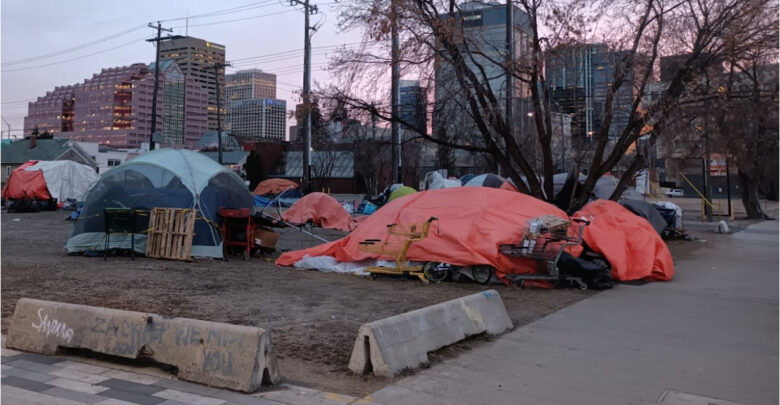 Andie Hansen
Andie HansenIn order for social problems to be addressed, they need to be approached with compassion and understanding. This is no different for issues facing Edmonton’s homeless population. Currently, the city is seeing unprecedented rates of drug-related deaths amongst homeless people. In the span of three months, 118 people died from drug poisoning or other factors of homelessness and poverty.
“In my seven and a half years on Boyle Street, I’ve never seen as many people experiencing homelessness and poverty in our city as we’re currently seeing right now,” Elliott Tanti, the director of communications and engagement at Boyle Street Community Services, said in an interview with The Gateway on November 10. He noted that in the month before the interview, nearly 60 people died.
The high death rates show that something is wrong and needs to change. But, these problems will take a long time to solve, and things are not moving quickly.
To their credit, city councillors are listening and responding to this situation. But, in the meantime, they must contend with very real public safety concerns. While Edmontonians have the right to be concerned about their safety, the current rhetoric has come at the cost of dehumanizing homeless people.
It’s important for students and the general public to feel safe. However, maintaining public safety sustainably cannot be done by dehumanizing the unhoused. Instead, we need to respond to people’s needs while recognizing intergenerational trauma. This can help address the root causes of homelessness. Often, efforts to improve public safety end up impacting services provided to help homeless people. The result is a never-ending vicious cycle where services for either concern are not where they should be.
Unfortunately, people’s genuine need for safety can turn into an excuse to look the other way when hundreds of people are dying. To see this, look no further than Edmonton’s clashing priorities. Due to safety concerns, the city revised a bylaw to prevents loitering and using drugs in LRT stations. Yet, police still regularly tear down encampments that unhoused people use for shelter over concerns from nearby neighbourhoods and business owners. The end result is people getting stuck between a rock and a hard place: a transit station where they might be kicked out, or the cold.
Preventing police from tearing down encampments would likely improve transit safety indirectly. More importantly, allowing people to stay in encampments during winter would remove a pointless obstacle that unhoused people face. Currently, groups of campers often rotate through several areas after being evicted from one location, in a process that has been compared to whack-a-mole. Bringing in police to tear down encampments is not only needlessly oppressive, but it’s also expensive. There is no reason to tear down encampments during the winter months. Doing so only adds to the problem.
The warmer weather offers a much-needed reprieve to prepare for winter. With funding from the city and $22 million from the province, Edmonton has set up 1,700 shelter spaces. The city now says it has enough shelters for this winter. But, with at least 3,000 people experiencing homelessness in Edmonton, it could still be difficult to access necessary services. Housing is only one solution out of many. We desperately need to fund support services that address different dimensions of homelessness, including the opioid crisis.
Despite the challenges, Boyle Street continues to do good and innovative work, Tanti emphasized. “People are getting housed, people are getting into recovery, [and] people are getting clean,” he said. “It’s not about something not working. The conversation is really about doing more of what is working.”
With so many issues often compounding on each other, there’s often confusion about where to direct funding. For the opioid crisis, it may seem like different models of care are in conflict. On one hand, harm reduction aims to prevent drug poisoning through interventions such as needle exchange. On the other, a recovery-oriented approach involves getting people into programs to help them overcome addictions. This latter approach has been the focus of the current provincial government. However, the two approaches can complement rather than compete with each other.
There is a common saying: you can’t go to recovery if you’re dead. Some people are not at the place where they are ready for recovery. In those cases, harm reduction saves lives, even when the ultimate aim is recovery. Meanwhile, Tanti noted that most people they work with have sobriety as their end goal. They would benefit from improved access to recovery programs. Even so, recovery takes time, so it’s crucial for the city to be compassionate by offering services that meet people where they’re at.
Unfortunately, Edmonton Police Service (EPS) are currently planning to tear down encampments across the city before Christmas. This is the complete opposite approach that we should be taking. Instead of treating homeless people with respect, EPS is choosing to displace these peoples’ homes and destroy their sense of community.
Organizations like Boyle Street Community Services are eager to work with the city and all levels of government, whatever their approach is. As students, we also have an opportunity to inform ourselves about the problems facing our community and take action. By choosing compassion, we can make the city safer for everyone.




